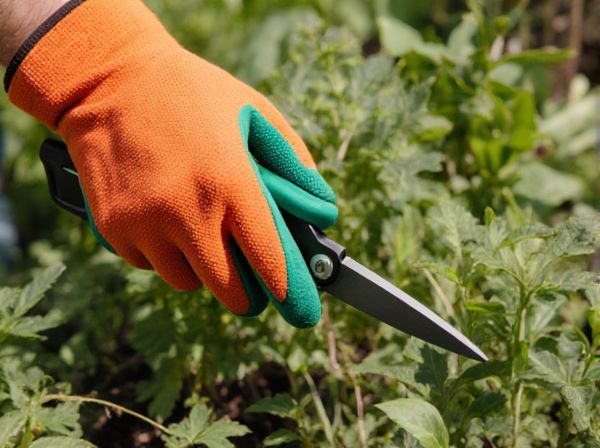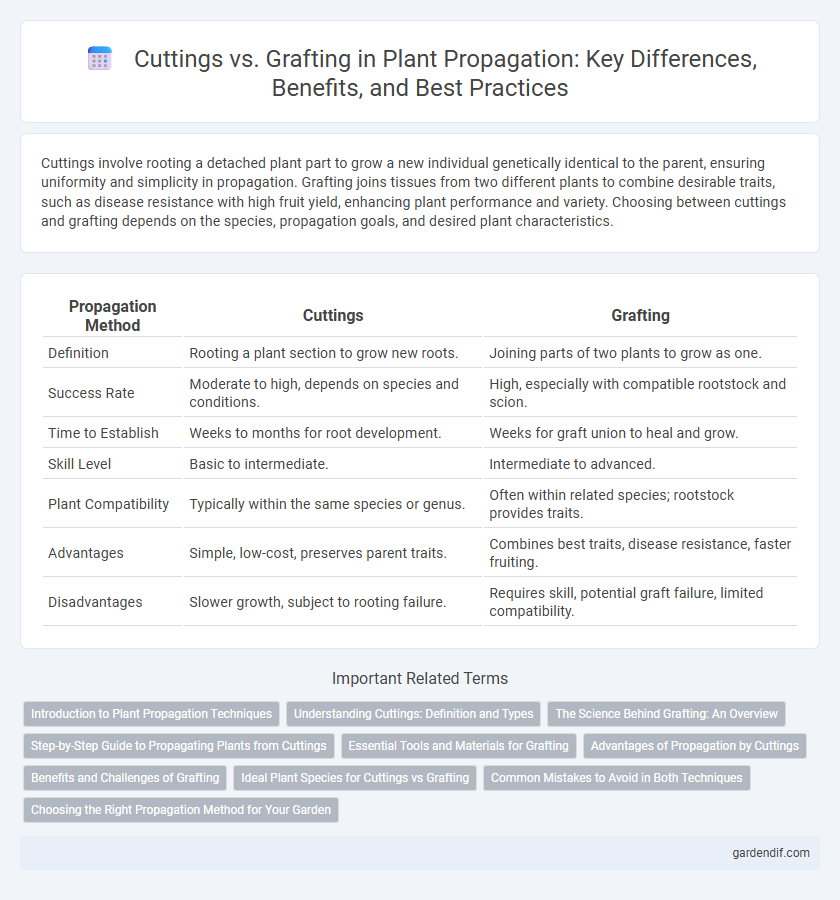
Cuttings vs Grafting Illustration
Cuttings involve rooting a detached plant part to grow a new individual genetically identical to the parent, ensuring uniformity and simplicity in propagation. Grafting joins tissues from two different plants to combine desirable traits, such as disease resistance with high fruit yield, enhancing plant performance and variety. Choosing between cuttings and grafting depends on the species, propagation goals, and desired plant characteristics.
Table of Comparison
| Propagation Method | Cuttings | Grafting |
|---|---|---|
| Definition | Rooting a plant section to grow new roots. | Joining parts of two plants to grow as one. |
| Success Rate | Moderate to high, depends on species and conditions. | High, especially with compatible rootstock and scion. |
| Time to Establish | Weeks to months for root development. | Weeks for graft union to heal and grow. |
| Skill Level | Basic to intermediate. | Intermediate to advanced. |
| Plant Compatibility | Typically within the same species or genus. | Often within related species; rootstock provides traits. |
| Advantages | Simple, low-cost, preserves parent traits. | Combines best traits, disease resistance, faster fruiting. |
| Disadvantages | Slower growth, subject to rooting failure. | Requires skill, potential graft failure, limited compatibility. |
Introduction to Plant Propagation Techniques
Cuttings involve rooting a part of a parent plant, such as a stem or leaf, to produce a genetically identical new plant, making this technique ideal for plants that root easily. Grafting combines the tissues of two plants--typically a rootstock and a scion--to unite desired traits, such as disease resistance and improved fruit quality, in a single plant. Both methods are fundamental in commercial and hobbyist horticulture for rapid propagation and maintaining cultivar characteristics.
Understanding Cuttings: Definition and Types
Cuttings involve propagating plants by detaching a part, such as a stem, leaf, or root, to develop a new plant with its own roots. Common types include stem cuttings, leaf cuttings, and root cuttings, each suited to different plant species. This method relies on the plant's ability to regenerate roots from the excised section, enabling efficient asexual reproduction.
The Science Behind Grafting: An Overview
Grafting involves joining the vascular tissues of two plants to enable nutrient and water flow, promoting successful union and growth. The rootstock provides a robust root system while the scion contributes desired traits, enhancing disease resistance and environmental adaptability. This process relies on cambial layer alignment and cellular differentiation, ensuring the merged plants function as a single organism.
Step-by-Step Guide to Propagating Plants from Cuttings
Propagating plants from cuttings involves selecting healthy stems, trimming them to about 4-6 inches with at least two nodes, and removing lower leaves to expose nodes for root development. Prepare a rooting hormone to dip the cut end, then plant the cutting in a sterile, well-draining medium like perlite or seed-starting mix, maintaining high humidity and consistent moisture. Place cuttings in indirect light at temperatures between 65-75degF until roots form, typically within 2-4 weeks, after which they can be transplanted to larger pots or the garden.
Essential Tools and Materials for Grafting
Essential tools for grafting include sharp grafting knives, grafting tape or rubber bands, and pruning shears, ensuring clean cuts and secure binding between rootstock and scion. In addition, grafting wax or sealant is necessary to protect the graft union from moisture loss and pathogens. Properly selected rootstock and compatible scion wood are crucial as fundamental materials to achieve successful grafting outcomes.
Advantages of Propagation by Cuttings
Propagation by cuttings offers rapid multiplication of plants while preserving the genetic traits of the parent, ensuring consistency in crop quality. This method requires minimal equipment and skilled labor compared to grafting, making it cost-effective and accessible for large-scale propagation. Cuttings also enable faster rooting and establishment, accelerating the growth cycle and increasing overall productivity in horticultural practices.
Benefits and Challenges of Grafting
Grafting promotes faster plant growth and enhances disease resistance by combining the best traits of rootstock and scion, leading to improved yield quality and environmental adaptability. However, it requires skilled labor and precise technique to ensure successful union and compatibility between plant varieties. Despite its complexity, grafting reduces juvenile periods and allows propagation of plants that are difficult to root from cuttings.
Ideal Plant Species for Cuttings vs Grafting
Woody plants such as roses, hibiscus, and figs respond well to cuttings due to their ability to root easily from stems or branches. Grafting is ideal for fruit trees like apples, pears, and citrus, where combining rootstock and scion enhances disease resistance and vigor. Succulents and herbs like rosemary propagate effectively through cuttings, while grafting benefits species with weak root systems or those requiring specific rootstock compatibility.
Common Mistakes to Avoid in Both Techniques
Common mistakes in cuttings include using non-sterile tools, incorrect timing for cutting collection, and improper humidity levels, which hinder rooting success. In grafting, errors frequently involve mismatched rootstock and scion compatibility, poor alignment of vascular cambium layers, and insufficient securing of the graft union. Ensuring clean cuts, optimal environmental conditions, and proper technique enhances propagation outcomes in both methods.
Choosing the Right Propagation Method for Your Garden
Cuttings offer a cost-effective and straightforward way to propagate many plants, preserving the parent plant's characteristics and enabling rapid growth. Grafting is ideal for combining desirable traits from two plants, enhancing disease resistance and fruit quality while allowing for earlier fruiting. Selecting the right propagation method depends on plant species, growth objectives, and available resources in your garden.
Cuttings vs Grafting Infographic

 gardendif.com
gardendif.com